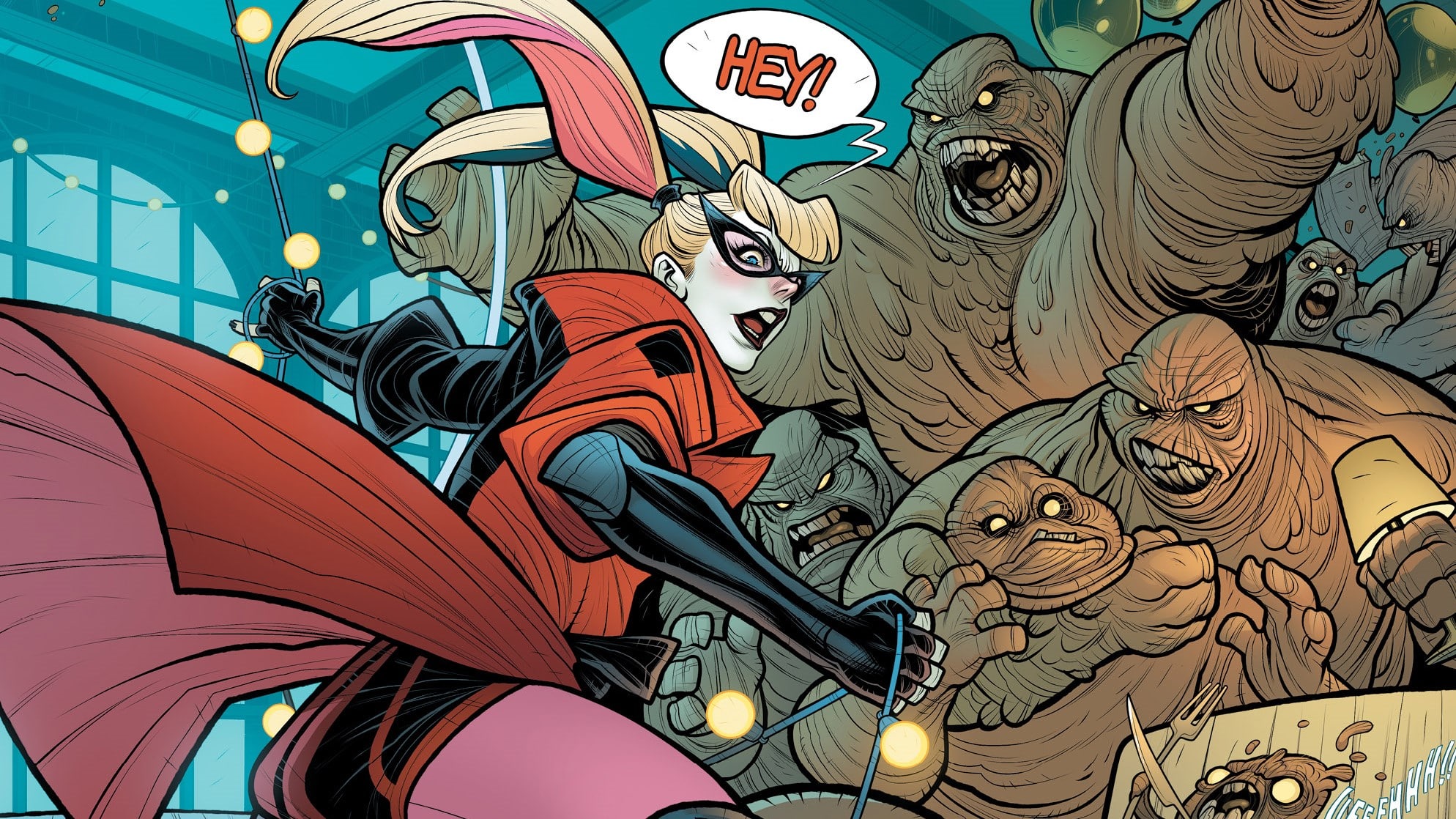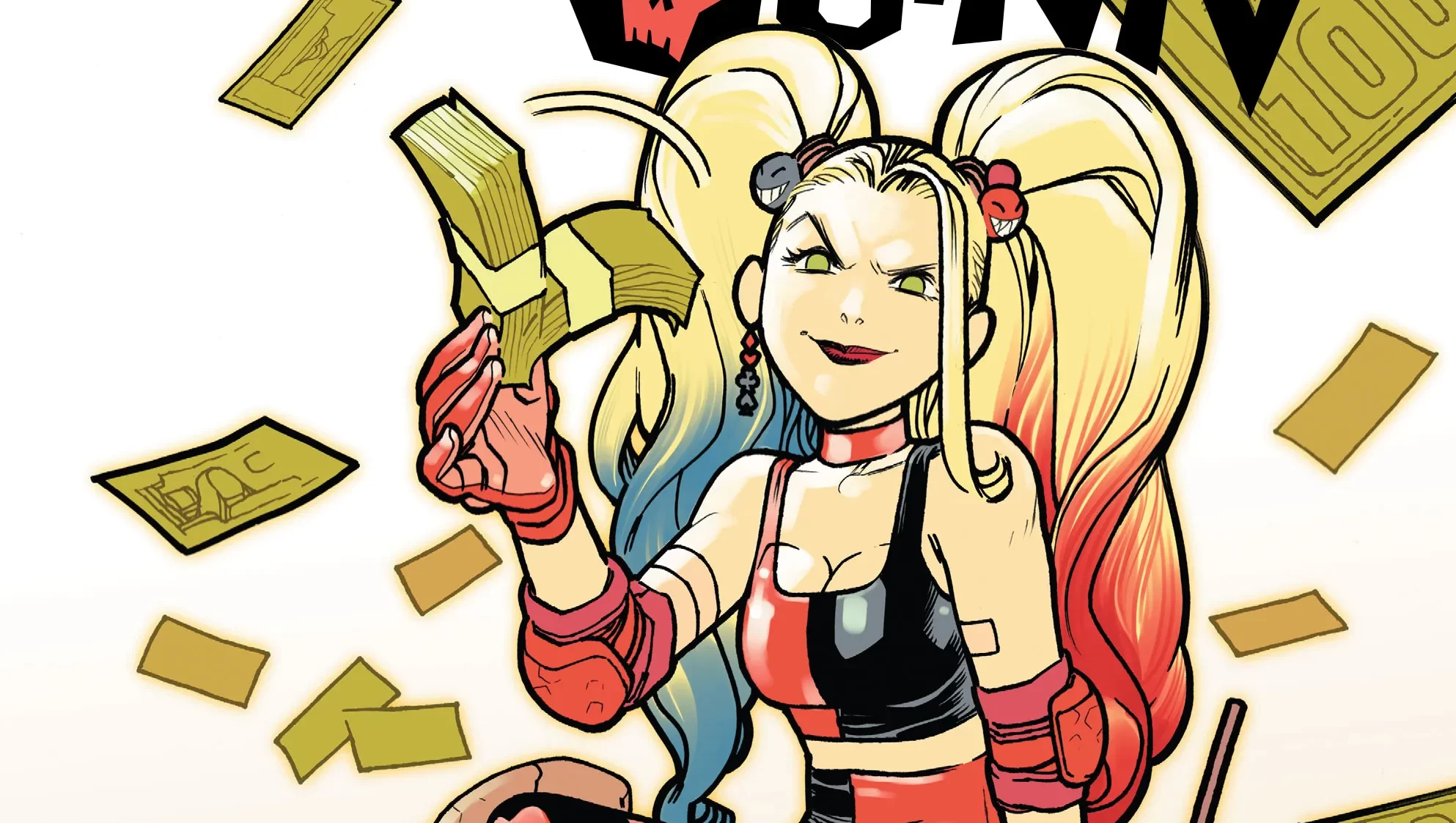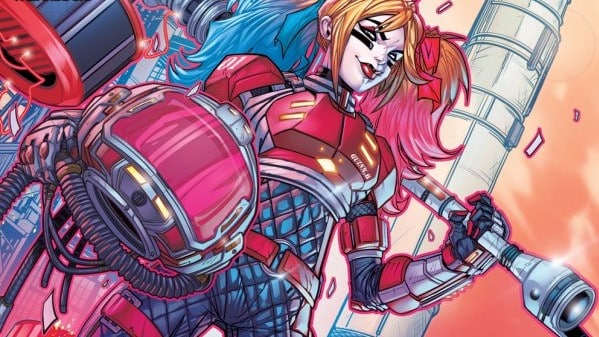It’s really easy to frame someone for murder when their most identifiable feature is a well recognized costume. Long story short, Harley’s in the clink for a crime she didn’t commit, feeling more than a little abandoned by her friends. The truth, however, rarely stays buried for too long in Gotham City — especially now that Batwoman’s on the case! Harley Quinn #14 is written by Stephanie Phillips, drawn by Riley Rossmo, colored by Ivan Plascencia and lettered by AndWorld Design.
We’ve had three major villains in this series so far, and Verdict has become my favorite. Not because her methodology, costume design, character motivations or even general personality are all that striking. What I like is what she’s bringing with her to the series.
With Hugo Strange as the villain, we got to see Harley at her lowest. Forced to face people’s hypocrisy in forgiving Strange for his past while she and friends were rounded up for their criminal pasts. With Keepsake, we saw her getting a bit of her power back; the man who would try to force her into her past role was soundly defeated as Harley defined her new life on her terms, and no one else’s. With Verdict, we once again have a villain who can only see Harley’s past, but it’s different here. Not the mad science and grand schemes of Strange, nor the desperate, silly, and envy-laden ploys of Keepsake, what we have here is someone burning with hatred, and the book’s taken on a more serious tone because of it.
Enter: The Batwoman
We open into darkness; a dark night for an even darker scene. Moonlight illuminated a statue of Justice, whose blind eyes are smeared with lines of blood, whose scales hold the eyeball of a corrupt judge, dead at her feet and bound to her pedestal. Batwoman and Oracle (whose return as a green-tinted digital voice connected to the Batfamily on their missions is a return I’m enjoying) banter back and forth about the crime scene, before Batwoman realizes she’s being watched, leading to her first scuffle with our villain, Verdict.
I’ve always enjoyed Riley Rossmo and Ivan Plascencia’s work on this comic, but this issue’s really kicked things up a notch in terms of mood. Rossmo’s work lends itself to silliness, which can be a challenge for an issue that’s taking things more seriously than it’s not, but Plascencia is up to the challenge. The way the moonlight falls on the statue of justice, silver beams of light in the air, a softness to Justice herself. The mesmerizing red of Batwoman’s glorious cape (I’m sorry, but Batman ain’t got nothing on a glorious red cape) and her amorphous cloud of red hair. The darkness of Gotham in moody dark gray-blues. A fight scene amidst flashes of lightning. The mood is grim, and dramatic, and Rossmo’s sillier, warbling lines become something else — something eerie, almost unsettling.
It’s not always that a crossover changes moods like this to accommodate a guest star, but I’m enjoying it.
Jailhouse Hues
The shift to a slightly more serious tone continues as we catch up with Harley. Not much in the way of wacky hijinks in jail, though wackiness isn’t far from her mind. Little visions of friends, foes and family flitter about her head, and Plascencia gives them this layered translucent pink-over-reds-and-blues look that achieves this mesmerizing not-quite-3D look.
There’s an action scene at the end of the issue, with Harley and Batwoman mixing it up with inmates, that uses these unique neons to frame certain moves in a wildly chaotic fight, and the colors pop in magical ways. The series has consistently managed to capture the chaos of a fight scene in the way only comics can, but the energy of this one is so far unmatched.
There’s nothing quite as frustrating as a criminal having to do time for the one crime they didn’t commit, though Harley’s taking it as well as can be expected. Given the number of times she’s been in and out of Arkham, it makes sense that she’d take a little stint in prison in stride, though she does miss the days where her old chaotic self would have made the stay a little more interesting.
What’s harder to take in stride, however, is the fact that Kevin isn’t 100% sure that she’s innocent.
I enjoyed how the scene was crafted. Harely’s joy at seeing Kevin dominates the top half of the two-page spread, those layered hearts (and other card suits) flying out from her head as she catches Kevin up to her time in prison. The bottom half of the spread is more confined. Talking heads, a panel each, as the conversation goes back and forth, a glowing, glaring red light in the background for most of them. The lighting is harsh — harsh as the realities Kevin’s forcing Harley to face.
As Harley finds that none of Batfamily have taken an interest in her case – which has to sting, no matter how many excuses she makes for them. She’s wanted to be a part of the Batfamily since the series began, but they haven’t really been around, they haven’t had the chance to get to know her. Kevin, however, has been there from #1, through the whole process of her rehabilitation. He’s seen the work she’s put in, and the progress she’s made — and it’s clear that him not believing in her hurts worse than anyone else’s judgment ever could.
Kevin
Back at home, though, we see that Kevin is a little more conflicted about Harley’s innocence than his call at prison might have indicated. He’s running through all the options — perhaps Harley was mind-controlled, or impersonated by a shapeshifting alien, or one of the other dozens of bizarre yet reasonable options that might apply in the DC Universe. I still can’t quite get over the fact, though, that no one seems to be considering the option that someone else simply wore Harley Quinn’s costume while committing the crimes.
Kevin’s girlfriend Sam believes that Harley’s guilty, though. I appreciated this scene…Kevin clumsily trying to cook his girlfriend breakfast while unburdening his woes to her. It’s a touching scene. I’d love this relationship, even with their disagreements…if it wasn’t for the clues that seem to indicate that Sam has been Verdict all along!
Poor Kevin.
We don’t know a lot about Sam, but I like the impression she’s been making so far. Letting us see her in the way we have been – at the museum, flirting with her boyfriend over breakfast, her messy room in a small apartment – she’s being humanized in a way that previous villains in this series haven’t been. I did not take Verdict seriously at all in her first appearance, but I’m growing steadily more invested in the character. Her costume looks bad, but it does look like the kind of thing thrown together by an amateur supervillain who has more rage than costume budgets. And that rage is, quite literally, sewn into her costume, too — verdicts are meant to have an equal chance of being one of innocence or guilt, but Verdict has “Guilt” sewn into her cape, her mask, anywhere the word can fit.
She’s growing on me, as a villain, and it feels like that’s what this series has been constantly doing. Growing. Gaining more depth, more cohesion between the creative team, raising the floor and then using it to explore new ways of storytelling. I’ve been having fun with this series, but now I’m intrigued in a way I haven’t fully been before.
My verdict’s in: this book is great.
Armaan is obsessed with the way stories are told. From video games to theater, TTRPGs to comics, he has written for, and about, them all. He will not stop, actually; believe us, we've tried.






